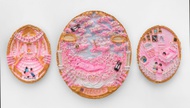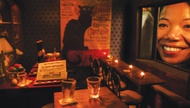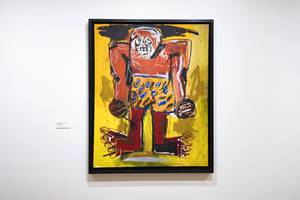At the intersection of Sammy Davis Jr., Frank Sinatra and Dean Martin drives sits Wayne Littlejohn’s latest creation, “Spin Baby,” dedicated to the members of the Rat Pack. The 15-foot-tall stainless steel and bronze microphone enveloped in a plume of spiraling smoke greets passing drivers, reminding them of an older Vegas—that of unfiltered cigarette-scented lounges and tipped fedoras.
A few miles south, in an open field at Siegfried and Roy Park, near McCarran International Airport, stands the 26-foot-tall older brother “Dream Machine.” The towering abstraction—a Fibonacci spiral sprouting, mushroom-like, from the earth—nods to Vegas’ atomic legacy. To Littlejohn, the Las Vegas landscape has become a metaphorical canvas, as he mimics the endless movement of the city in his public installations.
Born in Winnipeg, Canada, Littlejohn first came to Las Vegas in 1994 to join UNLV’s graduate art program. It was only supposed to be a brief stint, but he has since made the city his home, expanding his artistic footprint through his work and students at UNLV and now, CSN, where he teaches fine art.
Littlejohn says that beyond sculpting, he has always dabbled in drawing, but he ultimately felt confined by the limitations of trying to create the illusion of space within a two-dimensional plane. He longed for the freedom of playing with physical space.
“The sense of movement has always been big in my work,” he says. “I want to knock the corners off a rectangle, and make it a circular type of motion.”
Littlejohn says he’s also influenced by the ancient Greeks’ Contrapposto stance in sculptures. The term refers to a standing human figure carrying its weight on one leg, giving off an asymmetrical, twisted form.
“It’s almost like they’re about to start moving, or transition from one movement to another,” he says.
Another signature in Littlejohn’s work is the concept of levitating mass, and how light moves through it. Despite the prevailing stereotype that creative people are averse to science and mathematics, he believes artists have more aptitude for those subjects than they realize. Still, he considers himself more an alchemist than a chemist.
Public art installations like Littlejohn’s are crucial to the heritage of the city, he says, as they not only capture the defining characteristics and spirit of the community but also makes art more accessible to those who might not visit an art museum or gallery. “It reaches people in a more effective way because it’s part of the landscape,” he says.
Right now, Littlejohn is working on a piece for the City of Las Vegas, tentatively called “Atomic Tumbleweed,” which is currently being cast in stainless steel at a Colorado facility. The spherical sculpture is expected to be installed in the Arts District this spring.
Though he says he always felt drawn to public art, Littlejohn never imagined he would someday be selected by both the City and Clark County to create pieces. “It came as a surprise to me,” he says, adding that officials from both municipalities have been “awesome to work with.”
Still, the Valley has a long way to go in carving an identity for itself as a arts hub, he says. “It’s always been a struggle between the Strip and the arts community,” he says. “Bringing art to the community has always ebbed and flowed, and I still think we are very young. We need more cultural institutions that are free-standing, like an art museum or a real museum of art and history. The potential is really there. We just need to get it going.”







